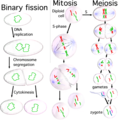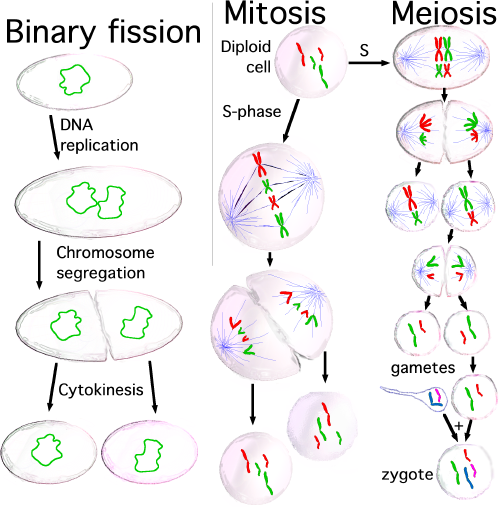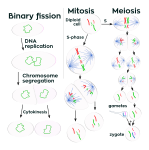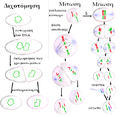Three types of cell reproduction are compared: the relatively simple Binary fission and two more complicated types that either involve mitosis or meiosis.
Binary fission. Organisms such as bacteria typically have a single chromosome (green). At the start of the binary fission process, the DNA molecule of the cell's chromosome is replicated, producing two copies of the chromosome. A key aspect of bacterial cell reproduction is making sure that each daughter cell gets a copy of the chromosome. Cytokinesis is the actual physical separation of the two new daughter cells.
Cell reproduction that involves mitosis. Most eukaryotic organisms like humans have more than one chromosome. In order to make sure that a copy of each chromosome gets segregated into each daughter cell, the spindle apparatus is used (blue threads). The chromosomes are moved along the long thin microtubules like trains moving along train tracks. Humans are diploid; we have two copies of each type of chromosome, one from the father (red) and one from the mother (green).
Cell reproduction that involves meiosis. The human sex cells (gametes) are produced by meiosis. For sperm production there are two cytokinesis steps that produce a total of four cells, each with half the normal number of chromosomes. The situation is different in the ovaries for egg production where one of the four sets of chromosomes that is segregated is placed in a large egg cell, ready to be combined with the DNA from a sperm cell (see meiosis for details).
This image was created for the cell growth article.
Source: I made this diagram with ClarisDraw and PhotoShop.
Note: a GFDL license for use of this image was automatically granted when I uploaded the image to Wikipedia. Since User:Bevo requested an explicit copyright status statement and since the Wikipedia:Image description page article suggests that "Adding explicit copyright information helps", I am providing one:
- The copyright to this image is retained by John Schmidt (JWSchmidt).
The Wikipedia:Image description page also suggests including an explicit statement about the GFDL license, so:
- Permission is granted to copy, distribute and/or modify this image under the terms of the Wikipedia GFDL, as indicated in the fine print at the bottom of this page. JWSchmidt 15:11, 11 Apr 2004 (UTC)
Source: English Wikipedia, original upload see file history

|
已授權您依據自由軟體基金會發行的無固定段落、封面文字和封底文字GNU自由文件授權條款1.2版或任意後續版本,對本檔進行複製、傳播和/或修改。該協議的副本列在GNU自由文件授權條款中。http://www.gnu.org/copyleft/fdl.htmlGFDLGNU Free Documentation Licensetruetrue
|

 
|
此檔案採用共享創意 姓名標示-相同方式分享 3.0 未在地化版本授權條款。
|
|
|
|
- 您可以自由:
- 分享 – 複製、發佈和傳播本作品
- 重新修改 – 創作演繹作品
- 惟需遵照下列條件:
- 姓名標示 – 您必須指名出正確的製作者,和提供授權條款的連結,以及表示是否有對內容上做出變更。您可以用任何合理的方式來行動,但不得以任何方式表明授權條款是對您許可或是由您所使用。
- 相同方式分享 – 如果您利用本素材進行再混合、轉換或創作,您必須基於如同原先的相同或兼容的條款,來分布您的貢獻成品。
|
| 已新增授權條款標題至此檔案,作為GFDL授權更新的一部份。http://creativecommons.org/licenses/by-sa/3.0/CC BY-SA 3.0Creative Commons Attribution-Share Alike 3.0truetrue
|
File history English Wikipedia
(del) (cur) 21:51, 6 July 2004 . . Guanaco (174122 bytes) (transparency, crop, optimize)
(del) (rev) 05:21, 31 March 2004 . . JWSchmidt (176449 bytes)
(del) (rev) 04:21, 31 March 2004 . . JWSchmidt (176121 bytes)
(del) (rev) 03:54, 31 March 2004 . . JWSchmidt (172333 bytes) (Three types of cell growth are compared.)
derivative works
[編輯]
SVG:
PNG:















